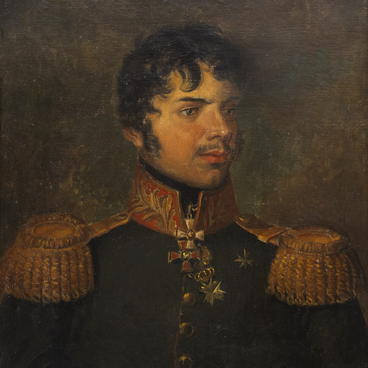Mikhail Andreyevich Miloradovich was a nobleman from the Poltava Governorate. As an infant, he was enlisted in the army, and at the age of nine he was transferred to the Izmaylovsky Life Guards Regiment as a junior ensign. From 1788 to 1790, he participated in the Russo-Swedish War.
In 1797, Mikhail Miloradovich received the rank of colonel, and a year later, at the age of 27, — major general. He was appointed chief of the Absheron Musketeer Regiment. With the regiment, he participated in the Italian and Swiss campaigns led by Alexander Vasilyevich Suvorov.
During the campaign of 1805, he commanded an infantry brigade. Miloradovich was awarded the Order of St. George, 3rd class and the rank of lieutenant general for his efforts. In 1809, for the victory at Rassevat, he was promoted to infantry general.
With the beginning of the Patriotic War of 1812, Mikhail Miloradovich formed reserves, with which he arrived to the active armies in August. In the Battle of Borodino, he commanded the troops of the right flank, after — the rearguard, and while pursuing the enemy — the vanguard of the Russian army.
For the successful actions of his corps at the beginning of 1813, he was the first to be awarded the right to wear the imperial monogram on epaulets, and for his skillful leadership of the troops, he was honored with the title of count of the Russian Empire.
In the campaign of 1814, Miloradovich commanded all the guard units of the Allies, after which he headed the Russian Guards Corps. In 1818, he became the St. Petersburg military governor-general. On December 14, 1825, on the day of the uprising on the Senate Square, he attempted to convince the rebel soldiers to return to the barracks, but was mortally wounded.
A portrait of Mikhail Miloradovich was painted by the English artist George Dawe in the 1820s. According to romantic aesthetics, the general does not look directly at the viewer, but is slightly turned away, gazing into the distance and slightly upwards.
The reproduction of the portrait displayed in the Borodino Museum-Reserve was made in the 19th century by an unknown artist for the general’s relatives. In 1886, Major General Grigory Alexandrovich Miloradovich presented the portrait as a gift to the Moscow Assembly of the Nobility, and in Soviet times it was kept in the Hermitage, from where it was transferred to the Borodino Museum after the Great Patriotic War.


